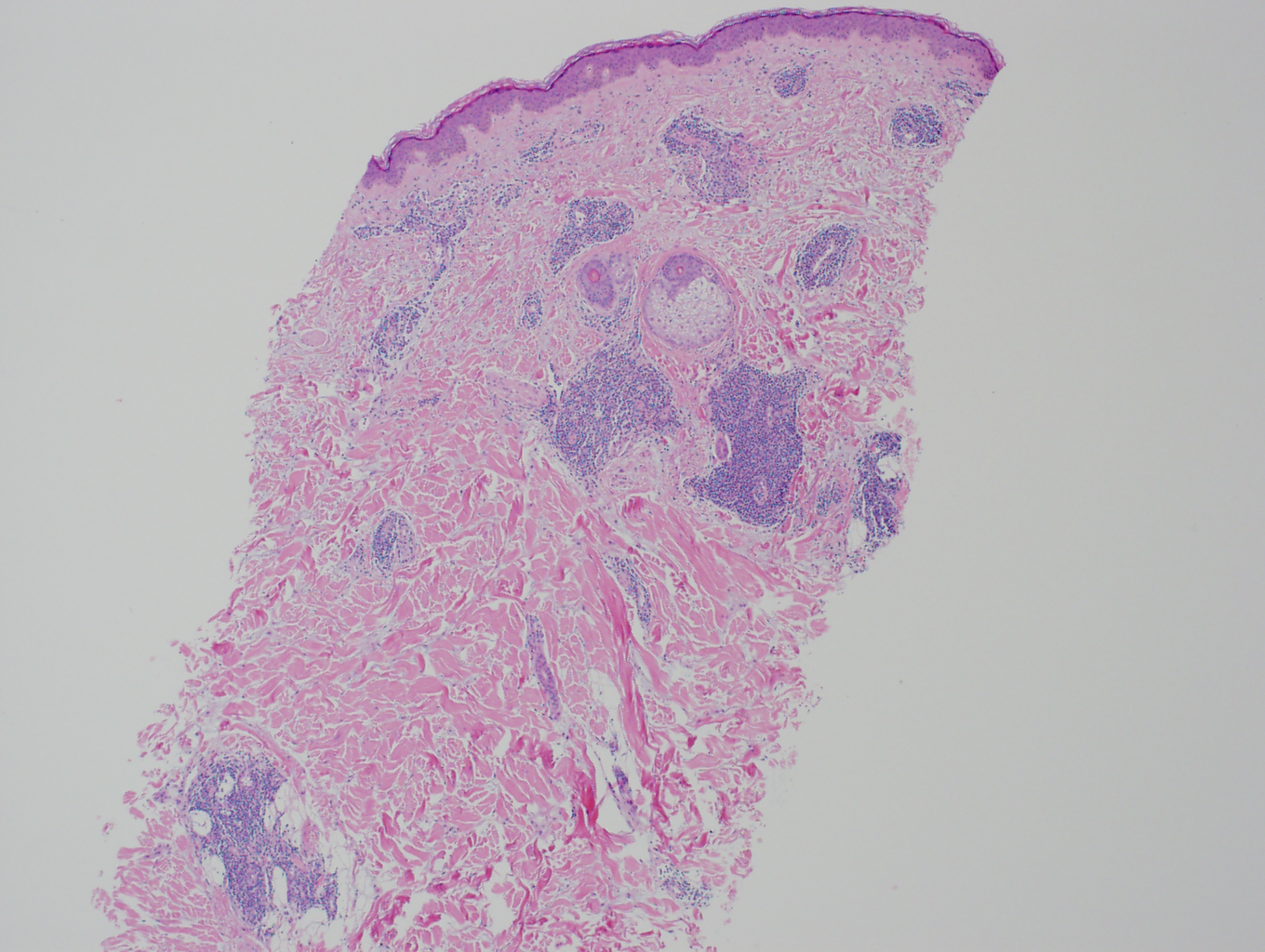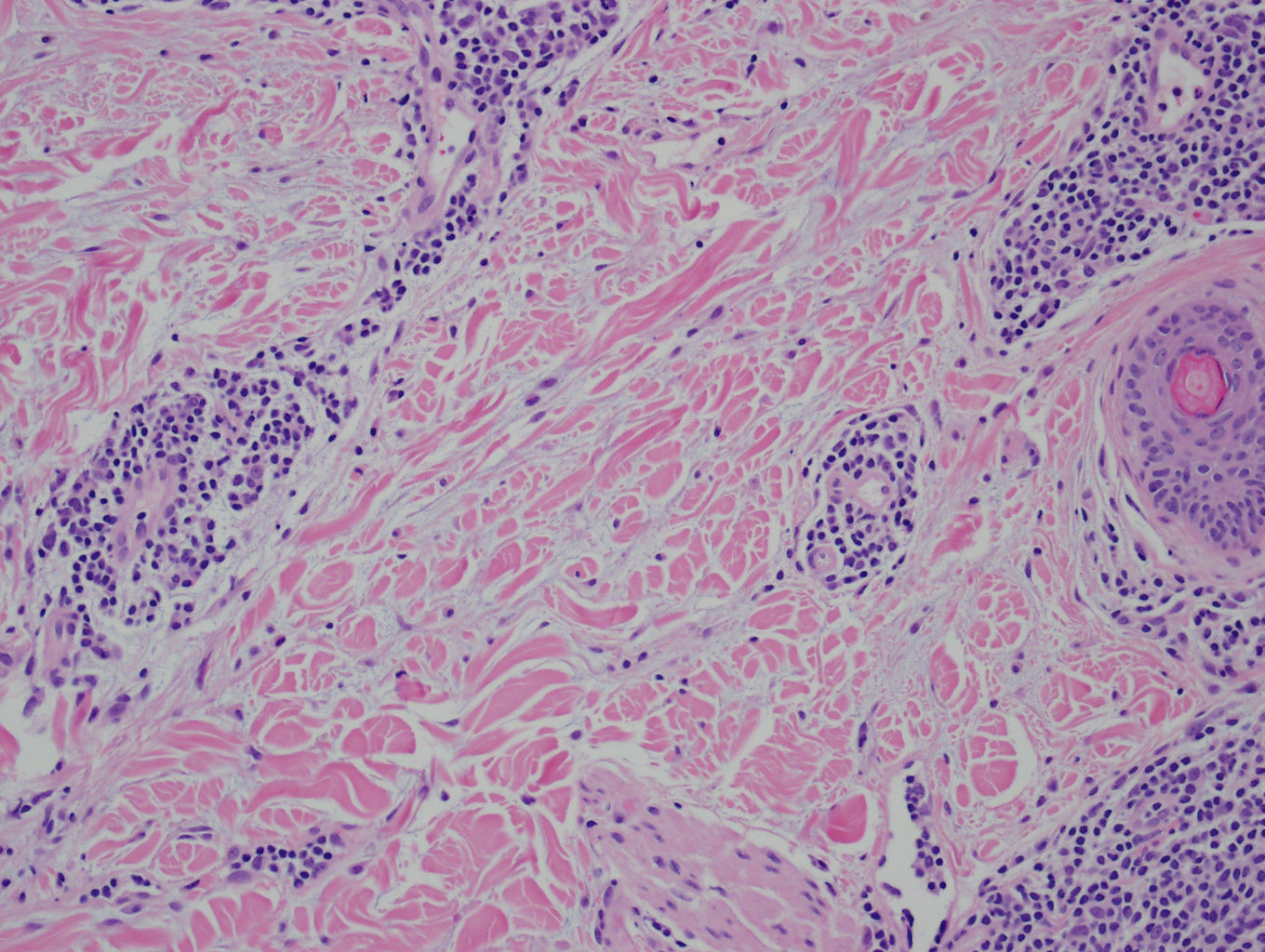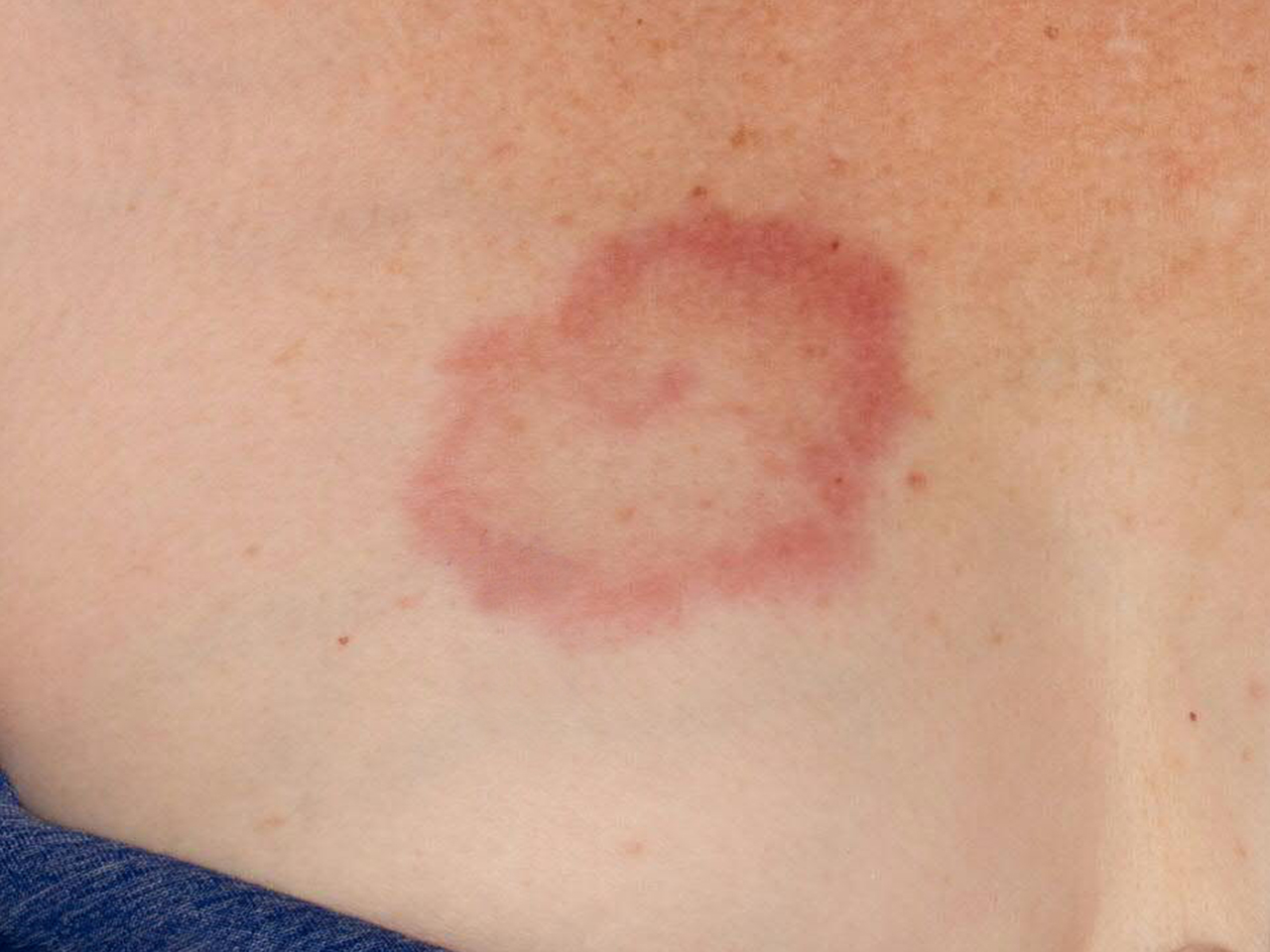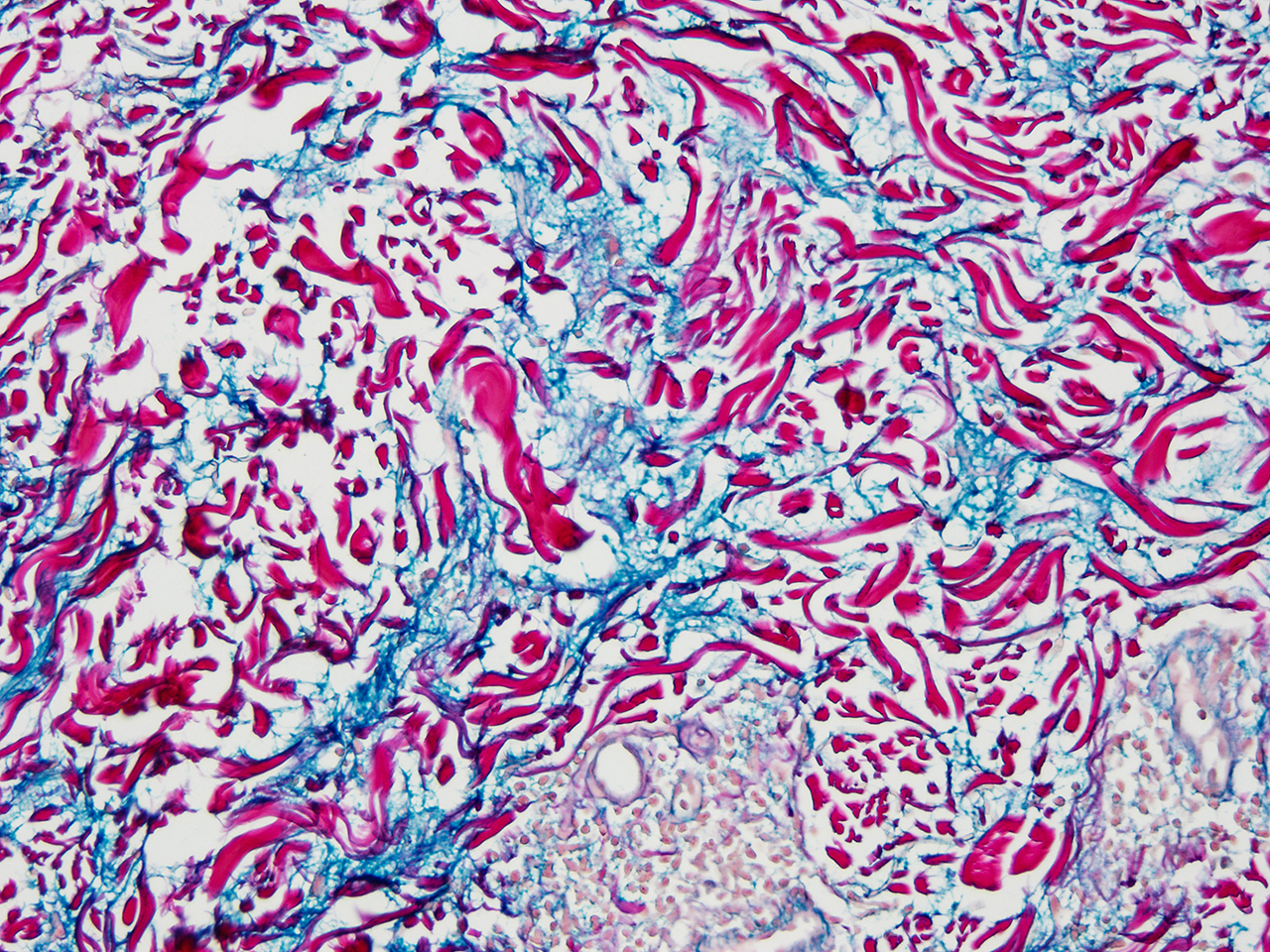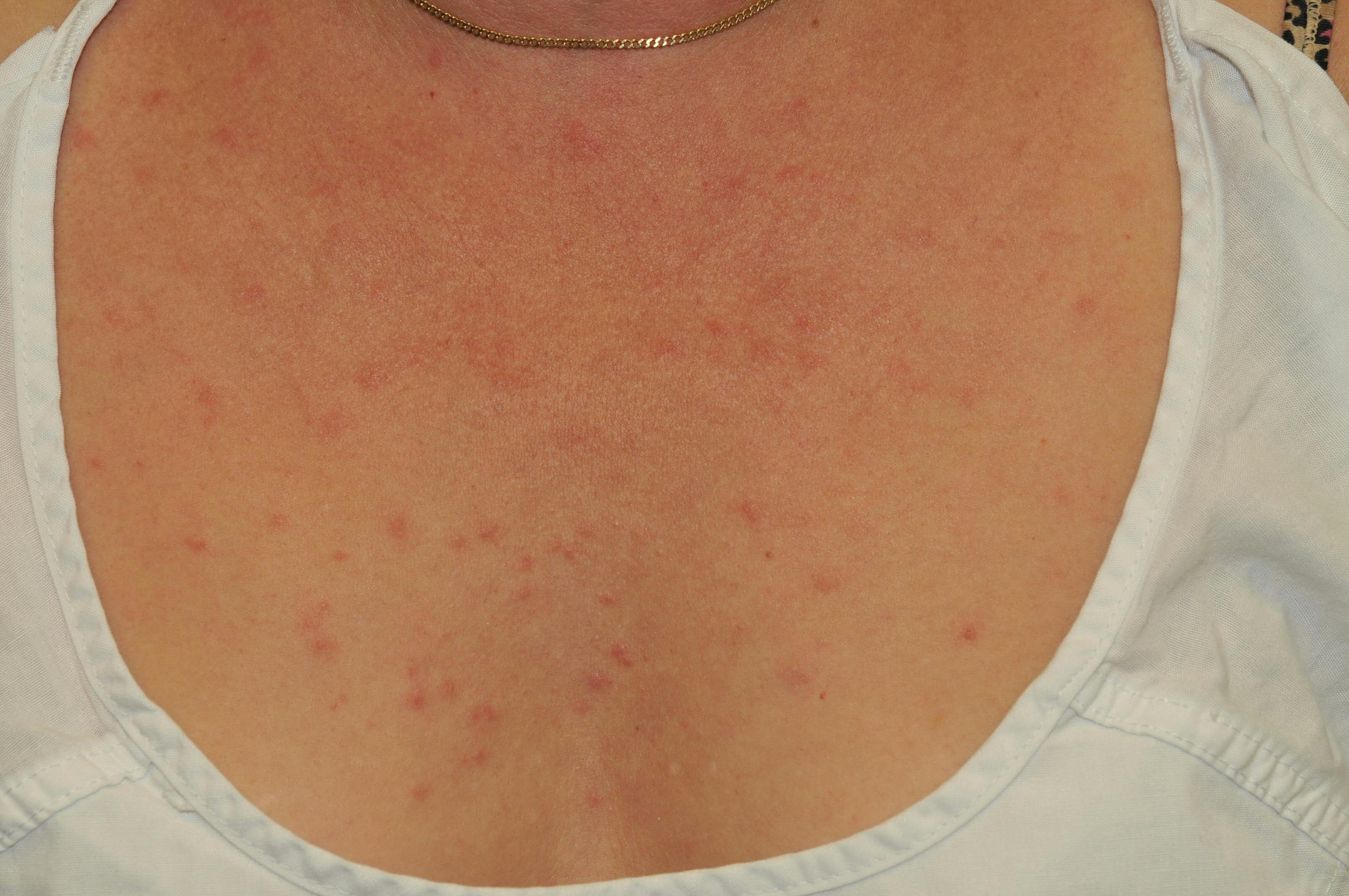[1]
Sontheimer RD, The lexicon of cutaneous lupus erythematosus--a review and personal perspective on the nomenclature and classification of the cutaneous manifestations of lupus erythematosus. Lupus. 1997;
[PubMed PMID: 9061656]
Level 3 (low-level) evidence
[3]
Abadías-Granado I,Sánchez-Bernal J,Felipo-Berlanga F,Ara-Martín M, Coexistence of Tumid Lupus Erythematosus and Discoid Lupus Erythematosus. Actas dermo-sifiliograficas. 2018 Jul 30;
[PubMed PMID: 30072022]
[4]
Powell R,Hile G,Lowe L,Kahlenberg JM, Herpes zoster infection after topical steroid use in the setting of tumid lupus erythematosus. JAAD case reports. 2018 Jan;
[PubMed PMID: 29379863]
Level 3 (low-level) evidence
[5]
Jefferson GD,Aakalu VK,Braniecki M, Tumid lupus: An unexpected diagnosis for the otolaryngologist. American journal of otolaryngology. 2017 Mar - Apr;
[PubMed PMID: 28122678]
[6]
Fogagnolo L,Soares TC,Senna CG,Souza EM,Blotta MH,Cintra ML, Cytotoxic granules in distinct subsets of cutaneous lupus erythematosus. Clinical and experimental dermatology. 2014 Oct;
[PubMed PMID: 25214407]
[7]
Gambichler T,Pätzholz J,Schmitz L,Lahner N,Kreuter A, FOXP3+ and CD39+ regulatory T cells in subtypes of cutaneous lupus erythematosus. Journal of the European Academy of Dermatology and Venereology : JEADV. 2015 Oct
[PubMed PMID: 25808110]
[8]
Böckle BC,Sepp NT, Smoking is highly associated with discoid lupus erythematosus and lupus erythematosus tumidus: analysis of 405 patients. Lupus. 2015 Jun
[PubMed PMID: 25411260]
[9]
Schneider SW,Staender S,Schlüter B,Luger TA,Bonsmann G, Infliximab-induced lupus erythematosus tumidus in a patient with rheumatoid arthritis. Archives of dermatology. 2006 Jan
[PubMed PMID: 16415403]
[10]
Vieira V,Del Pozo J,Yebra-Pimentel MT,Mart�nez W,Fonseca E, Lupus erythematosus tumidus: a series of 26 cases. International journal of dermatology. 2006 May;
[PubMed PMID: 16700782]
Level 3 (low-level) evidence
[11]
Schmitt V,Meuth AM,Amler S,Kuehn E,Haust M,Messer G,Bekou V,Sauerland C,Metze D,Köpcke W,Bonsmann G,Kuhn A, Lupus erythematosus tumidus is a separate subtype of cutaneous lupus erythematosus. The British journal of dermatology. 2010 Jan
[PubMed PMID: 19712116]
[12]
Yu C,Chang C,Zhang J, Immunologic and genetic considerations of cutaneous lupus erythematosus: a comprehensive review. Journal of autoimmunity. 2013 Mar
[PubMed PMID: 23380467]
[13]
Braddock SW, Kay HD, Maennle D, McDonald TL, Pirruccello SJ, Masih A, Klassen LW, Sawka AR. Clinical and immunologic studies in reticular erythematous mucinosis and Jessner's lymphocytic infiltrate of skin. Journal of the American Academy of Dermatology. 1993 May:28(5 Pt 1):691-5
[PubMed PMID: 8496412]
[14]
Verma P,Sharma S,Yadav P,Namdeo C,Mahajan G, Tumid lupus erythematosus: an intriguing dermatopathological connotation treated successfully with topical tacrolimus and hydroxyxhloroquine combination. Indian journal of dermatology. 2014 Mar;
[PubMed PMID: 24700961]
[15]
Bajaj DR,Devrajani BR,Matlani BL, Discoid lupus erythematosus: a profile. Journal of the College of Physicians and Surgeons--Pakistan : JCPSP. 2010 Jun;
[PubMed PMID: 20642962]
[16]
Goerig R,Vogeler C,Keller M, Atypical presentation of cutaneous lupus mucinosis. The Journal of clinical and aesthetic dermatology. 2013 Apr;
[PubMed PMID: 23630641]
[17]
Abdullah L,Abbas O, Dermacase: Can you identify this condition? Tumid lupus erythematosus. Canadian family physician Medecin de famille canadien. 2012 Jul;
[PubMed PMID: 22798463]
Level 3 (low-level) evidence
[18]
Chang J,Werth VP, Therapeutic options for cutaneous lupus erythematosus: recent advances and future prospects. Expert review of clinical immunology. 2016 Oct
[PubMed PMID: 27249209]
Level 3 (low-level) evidence
[19]
Rémy-Leroux V, Léonard F, Lambert D, Wechsler J, Cribier B, Thomas P, Adamski H, Marguery MC, Aubin F, Leroy D, Bernard P. Comparison of histopathologic-clinical characteristics of Jessner's lymphocytic infiltration of the skin and lupus erythematosus tumidus: Multicenter study of 46 cases. Journal of the American Academy of Dermatology. 2008 Feb:58(2):217-23
[PubMed PMID: 18083273]
Level 2 (mid-level) evidence
[20]
Lipsker D, Mitschler A, Grosshans E, Cribier B. Could Jessner's lymphocytic infiltrate of the skin be a dermal variant of lupus erythematosus? An analysis of 210 cases. Dermatology (Basel, Switzerland). 2006:213(1):15-22
[PubMed PMID: 16778421]
Level 3 (low-level) evidence
[22]
Cinotti E,Merlo V,Kempf W,Carli C,Kanitakis J,Parodi A,Rongioletti F, Reticular erythematous mucinosis: histopathological and immunohistochemical features of 25 patients compared with 25 cases of lupus erythematosus tumidus. Journal of the European Academy of Dermatology and Venereology : JEADV. 2015 Apr;
[PubMed PMID: 25087914]
Level 3 (low-level) evidence
[23]
Cetinözman F,Jansen PM,Willemze R, Expression of programmed death-1 in primary cutaneous CD4-positive small/medium-sized pleomorphic T-cell lymphoma, cutaneous pseudo-T-cell lymphoma, and other types of cutaneous T-cell lymphoma. The American journal of surgical pathology. 2012 Jan
[PubMed PMID: 21989349]
[25]
Patsinakidis N,Kautz O,Gibbs BF,Raap U, Lupus erythematosus tumidus: clinical perspectives. Clinical, cosmetic and investigational dermatology. 2019;
[PubMed PMID: 31632119]
Level 3 (low-level) evidence
[26]
Kuhn A,Bein D,Bonsmann G, The 100th anniversary of lupus erythematosus tumidus. Autoimmunity reviews. 2009 May;
[PubMed PMID: 19162244]
[27]
Choonhakarn C,Poonsriaram A,Chaivoramukul J, Lupus erythematosus tumidus. International journal of dermatology. 2004 Nov;
[PubMed PMID: 15533063]
[28]
Kuhn A,Richter-Hintz D,Oslislo C,Ruzicka T,Megahed M,Lehmann P, Lupus erythematosus tumidus--a neglected subset of cutaneous Lupus erythematosus: report of 40 cases. Archives of dermatology. 2000 Aug
[PubMed PMID: 10926740]
Level 3 (low-level) evidence
[29]
Stead J,Headley C,Ioffreda M,Kovarik C,Werth V, Coexistence of tumid lupus erythematosus with systemic lupus erythematosus and discoid lupus erythematosus: a report of two cases of tumid lupus. Journal of clinical rheumatology : practical reports on rheumatic
[PubMed PMID: 18664992]
Level 3 (low-level) evidence
[30]
Kuhn A,Aberer E,Bata-Csörgő Z,Caproni M,Dreher A,Frances C,Gläser R,Klötgen HW,Landmann A,Marinovic B,Nyberg F,Olteanu R,Ranki A,Szepietowski JC,Volc-Platzer B, S2k guideline for treatment of cutaneous lupus erythematosus - guided by the European Dermatology Forum (EDF) in cooperation with the European Academy of Dermatology and Venereology (EADV). Journal of the European Academy of Dermatology and Venereology : JEADV. 2017 Mar;
[PubMed PMID: 27859683]
[31]
Kuhn A,Ruland V,Bonsmann G, Cutaneous lupus erythematosus: update of therapeutic options part I. Journal of the American Academy of Dermatology. 2011 Dec
[PubMed PMID: 20739095]
[32]
Sanders CJ,Van Weelden H,Kazzaz GA,Sigurdsson V,Toonstra J,Bruijnzeel-Koomen CA, Photosensitivity in patients with lupus erythematosus: a clinical and photobiological study of 100 patients using a prolonged phototest protocol. The British journal of dermatology. 2003 Jul
[PubMed PMID: 12890206]
[33]
Samotij D,Szczęch J,Werth VP,Furukawa F,Kuhn A,Szepietowski JC,Reich A, Disease severity and prophylactic measures in patients with cutaneous lupus erythematosus: results of a worldwide questionnaire-based study. Postepy dermatologii i alergologii. 2018 Apr
[PubMed PMID: 29760621]
[34]
Kuhn A,Gensch K,Haust M,Meuth AM,Boyer F,Dupuy P,Lehmann P,Metze D,Ruzicka T, Photoprotective effects of a broad-spectrum sunscreen in ultraviolet-induced cutaneous lupus erythematosus: a randomized, vehicle-controlled, double-blind study. Journal of the American Academy of Dermatology. 2011 Jan;
[PubMed PMID: 21167404]
Level 1 (high-level) evidence
[35]
Kreuter A,Gaifullina R,Tigges C,Kirschke J,Altmeyer P,Gambichler T, Lupus erythematosus tumidus: response to antimalarial treatment in 36 patients with emphasis on smoking. Archives of dermatology. 2009 Mar;
[PubMed PMID: 19289751]
[36]
Okon LG,Werth VP, Cutaneous lupus erythematosus: diagnosis and treatment. Best practice & research. Clinical rheumatology. 2013 Jun
[PubMed PMID: 24238695]
[37]
Kuhn A,Ruland V,Bonsmann G, Photosensitivity, phototesting, and photoprotection in cutaneous lupus erythematosus. Lupus. 2010 Aug
[PubMed PMID: 20693197]

